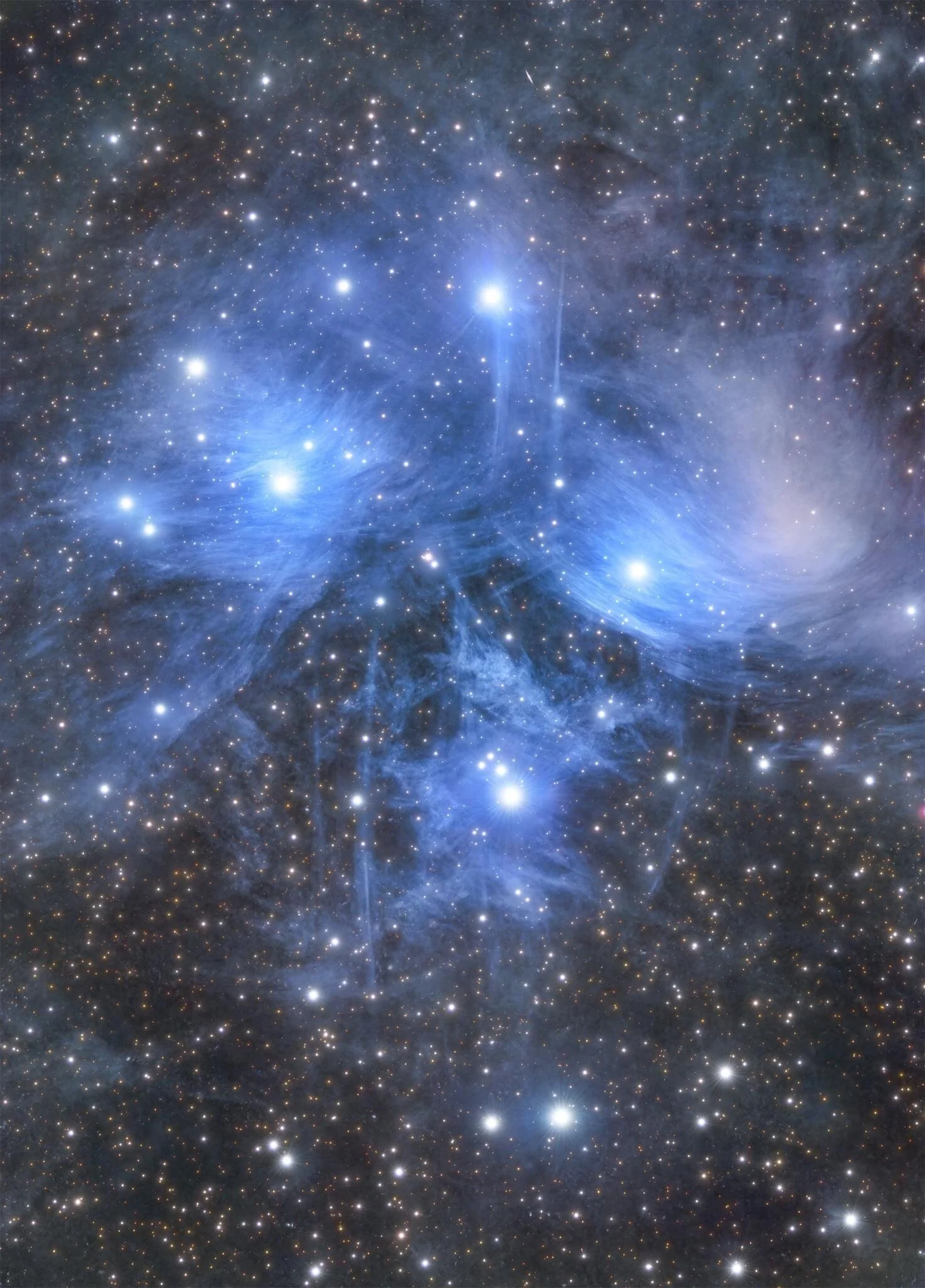
AAPOD2 Image Archives
New Noise in Subaru (m45: aka Pleiades)
M45, commonly known as the Pleiades or the Seven Sisters, is one of the most enchanting open star clusters in the night sky, located in the constellation Taurus. This celestial jewel, situated about 440 light-years away from Earth, is a captivating sight that has fascinated stargazers and storytellers for centuries. In this mesmerizing image, the delicate, blue-hot stars of the Pleiades cluster shine brightly against a backdrop of cosmic dust and gas, creating a celestial spectacle that never fails to inspire awe. The Pleiades have been celebrated in cultures around the world, and their presence in the night sky serves as a timeless reminder of the beauty and wonder that the universe has to offer.
M45 (Pleiades) in HOORGB
Image Description and Details : M45 (Pleiades) in HOORGB, 98 hours taken over the course of 19 nights.I've wanted to take this picture for a couple of years, but whenever I could get to my dark sky site, it was cloudy. The stars finally aligned (literally) and I was able to get a good amount of RGB data from my dark sky site this winter.During my research for taking this photo, I noticed that some images had small amount of faint Hydrogen Alpha immediately around M45, so I figured I'd pile on some HA data for my wide field image and see if any more hydrogen would present itself...I was pleasantly surprised to find some wispy streams of hydrogen that I'd never seen before, right outside of the star cluster.The RGB data was taken from my dark sky site in Bone Cave, TN. The narrowband data was taken from my backyard in Nashville, TN.Imaging details:Imaging Telescope: TPO UltraWide 180 f/4.5 Imaging Camera: ZWO ASI2600MC Pro Mount: Sky-Watcher EQ6-R Pro Filters:Baader Fringe Killer 2"Optolong L-eXtreme 2" Accessories: ZWO ASIAIR Plus, ZWO EAFSoftware: Adobe Photoshop, Aries Productions Astro Pixel Processor (APP), Pleiades Astrophoto PixInsightGuiding Telescope: ZWO 30mm Mini Guider ScopeGuiding Camera: ZWO ASI290MM Mini Dates:Nov. 18, 2022, Nov. 19, 2022, Nov. 20, 2022, Nov. 21, 2022, Nov. 22, 2022, Nov. 23, 2022, Nov. 28, 2022, Nov. 30, 2022, Dec. 12, 2022, Dec. 15, 2022, Dec. 16, 2022, Dec. 17, 2022, Dec. 18, 2022, Dec. 19, 2022, Dec. 20, 2022, Dec. 23, 2022, Dec. 24, 2022, Dec. 25, 2022, Dec. 27, 2022, Jan. 1, 2023Frames:Baader Fringe Killer 2": 538×240″ (35h 52′) (gain: 100.00) -10°COptolong L-eXtreme 2": 467×480″ (62h 16′) (gain: 100.00) -10°CTotal Integration: 98h 8′Darks: 60Flats: 60Flat darks: 100
Copyright: Copyright: Jeffrey Horne
m45
M45 - Pleiades: The Seven Sisters Star Cluster.
…lies about 444 light years away toward the constellation of the Bull (Taurus). A common legend with a modern twist is that one of the brighter stars faded since the cluster was named, leaving only six of the sister stars visible to the unaided eye. The actual number of Pleiades stars visible, however, may be more or less than seven, depending on the darkness of the surrounding sky and the clarity of the observer's eyesight.
Tech card:
Imaging telescope: Explore Scientific 127mm ED TRIPLET APO.
Imaging camera: ZWO ASI294MM-Pro.
Mount: iOptron CEM60.
Guiding camera: ZWO ASI290MM mini.
Focal reducer: Explore Scientific 0.7 Reducer/Flattener.
Accessory: ZWO OAG · ZWO EAF Electronic Auto Focuser · ZWO ASIAIR Pro · ZWO 8x 1.25" Filter Wheel (EFW).
Frames: Astrodon Gen 2 LRGB E Series: 80x120" (2h 40' ) (gain: 120.00) -20C bin 1x1.
Integration: 2h 40'
Darks: 50.
Flats: 30.
Flat darks: 30.
Avg. Moon age: 3.55 days.
Avg. Moon phase: 13.62%
Bortle Dark-Sky Scale: 4.00.
RA center: 03h46m41s.
DEC center: +24°09′32″
Pixel scale: 0.706 arcsec/pixel.
Orientation: 91.368 degrees.
Field radius: 0.943 degrees.
Re-process of my data of Feb. 15, 2021.
Imaging location: Abu Dhabi desert, UAE.
Copyright:Wissam Ayoub
Seven Sisters in a Dusty Veil
Image Description and Details :
Visible to the naked eye, the Seven Sisters, or the Pleiades, is one of the best known open clusters. The blue reflection nebula around it is a popular target for imagers. Very deep images, like this one, show the surrounding faint clouds and tendrils of dust as well as some red H(II) emission regions.Acquisition, focusing, and control of Paramount MX mount (unguided) with TheSkyX. Focus with Optec DirectSync motor and controller. Automation with CCDCommander. Equipment control with PrimaLuce Labs Eagle 3 Pro computer. All pre-processing and processing in PixInsight. Acquired from my SkyShed in Guelph. Average transparency and average seeing. Data acquired December 6, 2020 – February 9, 2020 under a moonless sky.Takahashi FSQ-106 ED IV @ f/5 and QHY367C Pro one-shot colour camera with Optolong UV/IR filter.123 x 5mTotal: 10hr15m Image scale 1.9 arcsec per pixel.
Copyright: Ron Brecher






